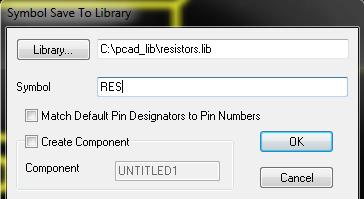Pcad 2006 Library
Feb 16, 2012 If i still remember, the easiest way for you to read the file would be to have the Altium Designer or Protel software. Read the Protel file and save it as an Orcad Capture design file (.DSN). You could then open it without having to mess with the SDT and library files. Hope this helps.
P-CAD was the brand name created by Personal CAD Systems, Inc., a company founded in 1982 in Los Gatos, California, by Richard Nedbal (CEO) and Roy Prasad (VP of Engineering). Both were former executives of American Microsystems, Inc. (AMI), a custom semiconductor company based in Santa Clara, California. Also, part of the founding team were Gregory Houston, VP Marketing, a former Calma executive, and Chi-Song Horng, Director of software engineering (later promoted as a Vice President), a former AMI software engineering manager.
We try to update our scuba service manuals database regularly and welcome our guests to send us files that are not yet present in our database please use the red send us your files link as shown on the top right. Dacor darwin dive computer manual. Dacor-dive-computer-manual 1/5 PDF Drive - Search and download PDF files for free. Dacor Dive Computer Manual Right here, we have countless books Dacor Dive Computer Manual and collections to check out. We additionally allow variant types and after that type of the books to browse. The customary book, fiction, history, novel, scientific.
Update on: 2020-04-08Requires Android: Android 4.2+ (Jelly Bean MR1, API 17)Signature: cbdafe45c220caf7c7c2f556189a7be2cccb0835Screen DPI: 160-640dpiArchitecture: arm64-v8aAPKs: config.ar, config.arm64v8a, config.de, config.en, config.es, config.fr, config.hi, config.in, config.it, config.iw, config.ja, config.ko, config.ms, config.nb, config.nl, config.pl, config.pt, config.ru, config.sv, config.th, config.tr, config.vi, config.xxhdpi, config.zhFile SHA1: 60cdb4e816f632b07f44ece9617a5c39f65ad749File Size: 8.2 MBWhat's new. Fonts.
P-CAD was a play on personal computers, which were just becoming popular, following the launch of the IBM PC. The vision of the company was to disrupt the existing hegemony of $250,000 CAD systems based on mainframe computers and custom workstations, and make electronic CAD available to the masses at a cost under $10,000.
The startup originally raised US$500,000 from CrossPoint Venture Partners, and US$3,000,000 in a second round from New Enterprise Associates and Robertson, Coleman and Stephens. The board of directors included John Mumford (Crosspoint), Dick Kramlich (NEA) and Sy Kaufman (Robertson, et al.).
P-CAD went on to become the company with the biggest installed base of users of Electronic Design Automation (EDA), with over 10,000 users by 1988. At that time, P-CAD was the most prolific EDA company as measured by its user base, easily surpassing established CAD companies such as Autotrol, Calma, Intergraph, Daisy, Mentor, Cadnetix, CAE Systems, ECAD, SDA Systems, etc. At that time, Cadence was just being formed with the merger of ECAD and SGA, and Synopsys was being founded as a new start up.
P-CAD's flagship products included schematic capture, logic simulation and PCB layout. Its single biggest customer was Texas Instruments. Other customers included most of the top electronic companies in the U.S., Europe and Japan. P-CAD also signed up IBM as a distribution partner, especially for Japan. Some of the key later additions to the P-CAD team who were instrumental in building up the company include former IBM and Xerox executive Jim Dick, former Apollo Computer VP, Mike Lack, former Apollo Computer Western Regional Sales Manager, Arthur Clark, and EDA industry veteran Ellis Smith, who managed P-CAD's Asia business. Key engineering managers included Bob Dean, Bill Newhard, Howard Schutzman, Alvin Hung, Felix Ruslim, Ron Rinaldi and Mark Houde. Key marketing/sales managers included Kirk Shorte, Steve Mayer, Bruce Fihe, Kathy Eggiman, Elizabeth Dessuge, Ken Lowe, Susan Scal, Donna Licot, Shahriar Emami, and John Roth, who as Director of Sales, was instrumental in bringing the first $5 million of sales into the company.
In 1989, P-CAD was acquired by Cadam, which was a subsidiary of Lockheed,[1] but was in the process of being sold to IBM.[2] At the time of acquisition, P-CAD had an installed base of over 100,000 end users, a record at that time. In those days, such a large user base was unheard of in the EDA industry.
A few years later, the P-CAD group was divested by selling to ACCEL Technologies, an EDA software corporation from San Diego, California, which was acquired by Protel International Pty Ltd (now Altium) in 2000. The P-CAD product included schematic capture, component library management, PCB layout and routing, parametric constraint solver and auto-routing capability.
The last version of P-CAD was P-CAD 2006 with Service Pack 2, released in 2006. This was the last release made by Altium, who retired the product in favor of Altium Designer. This was the final outcome that was originally expected at the time of the merger of Protel with ACCEL — that the best features of both product lines would eventually be combined.[3]
See also[edit]
References[edit]
- ^https://web.archive.org/web/20180415193540/https://www.computerwoche.de/a/lockheed-vereint-p-cad-und-cadam,1149259
- ^https://web.archive.org/web/20180415195158/http://www.cadhistory.net
- ^Protel Shareholder News, January 2000
